
Shortly after my wife and I bought our 1961 home in 2019, I discovered a serious problem in the basement. Where I could see it, the slab was cracked all along the edge of the exterior walls (photo above). I figured it might be causing elevated radon in my house, so I did what any normal person would do. I avoided testing my radon level. Until last spring, that is, when I found it was above where the US EPA says you should fix it. Now I’ve finally started doing something to get some reduction in our radon level.
What was wrong with my basement?
After doing a seven-day radon test in early April last year (2023), I dug into those cracks in my basement slab. You can see below what I found. Beneath the cracked slab was a piece of plastic sheeting. Beneath that was a layer of granite chunks. And beneath that was a corrugated plastic pipe.
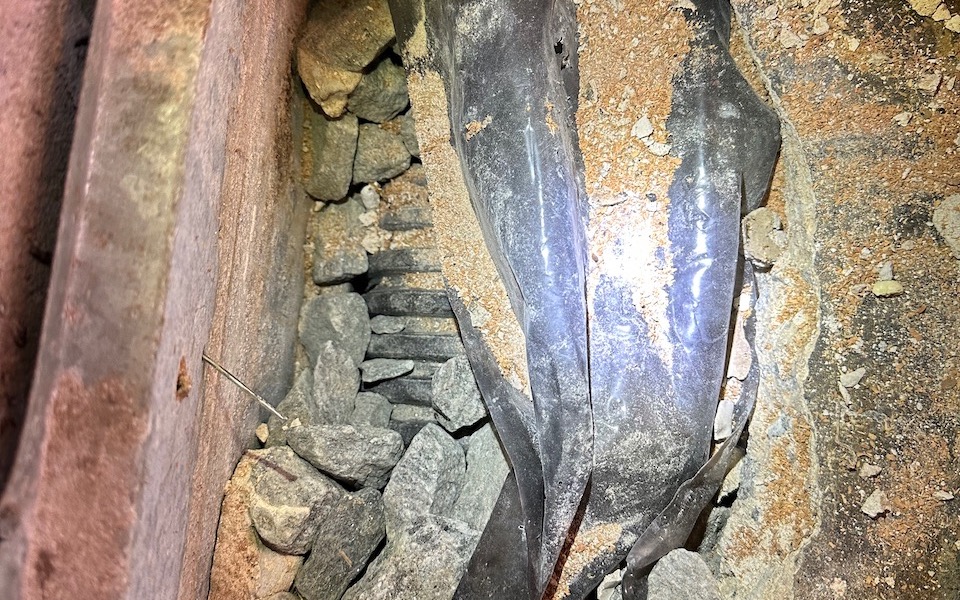
Yes, this was an interior perimeter drain system installed decades ago, but after the house was built. In addition to the cracks in the slab allowing soil gases to leak into the house, that piece of metal wasn’t sealed either. In some places, there were large gaps at the top edge or between it and the slab.
And then there was the mystery hole I saw shortly after we bought the house. That’s red Georgia clay you see in the middle of hole (photo below). Because it’s in a closet near the middle of the basement, it couldn’t be the same problem I had at the perimeter.
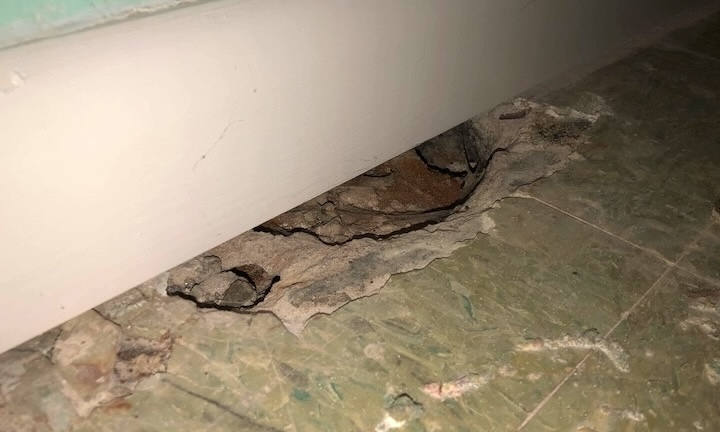
After getting the drywall removed, I discovered the reason for that mystery hole: a plumbing drain pipe that was added during a renovation after the house was built.
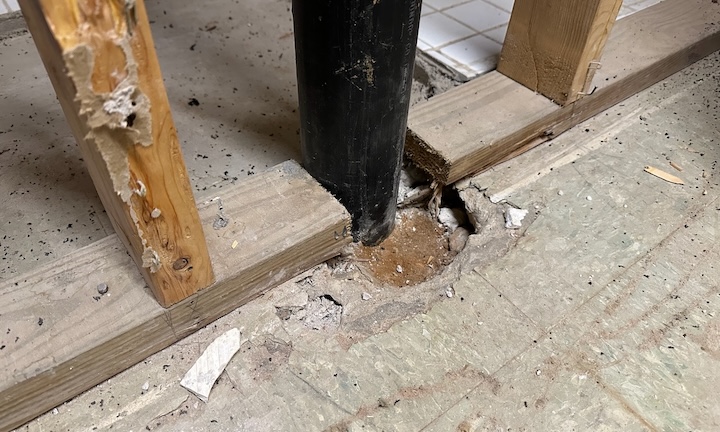
That hole is still open, but I’ll fix it after I remove that interior wall and get the bottom plate out of the way.
Soil gas leak sealing, so far
The first part of the basement renovation exposed the basement to more soil gases because we opened up the slab in multiple areas. But we also separated the basement from the house with plastic sheeting and put in continuous ventilation to exhaust air from the basement. (You can see the fan in the window below.)
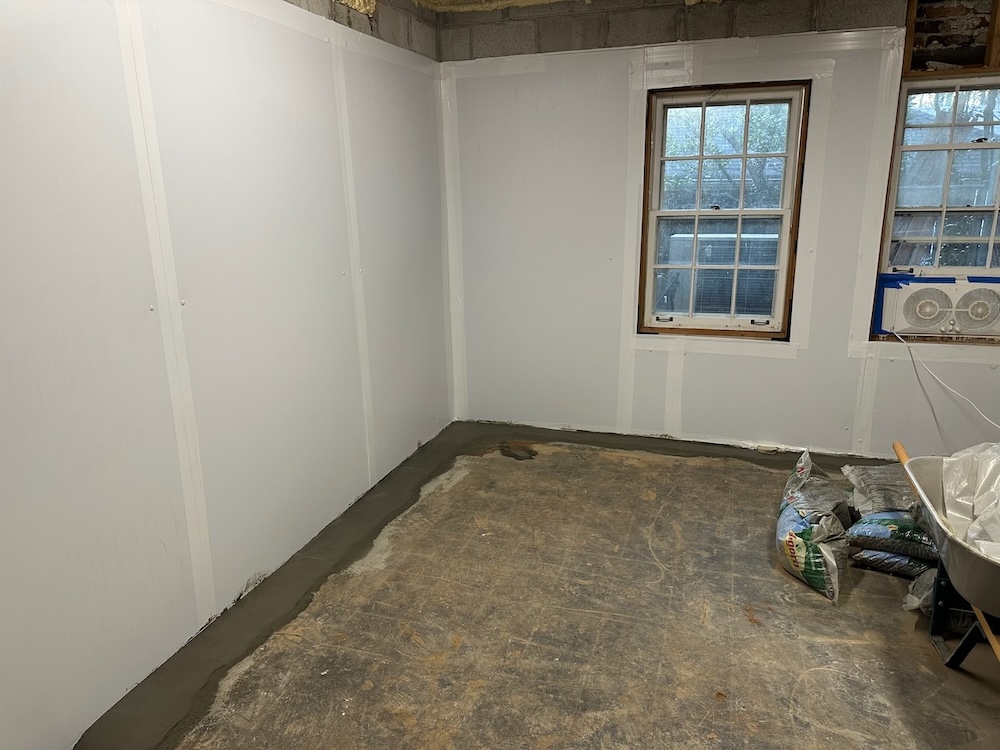
Since then, we’ve been closing up the slab and the concrete masonry unit (CMU) foundation walls. The photo above shows the new concrete over the new interior perimeter drain. And the plastic on the wall is sealed with tape and polyurethane sealant (mostly).
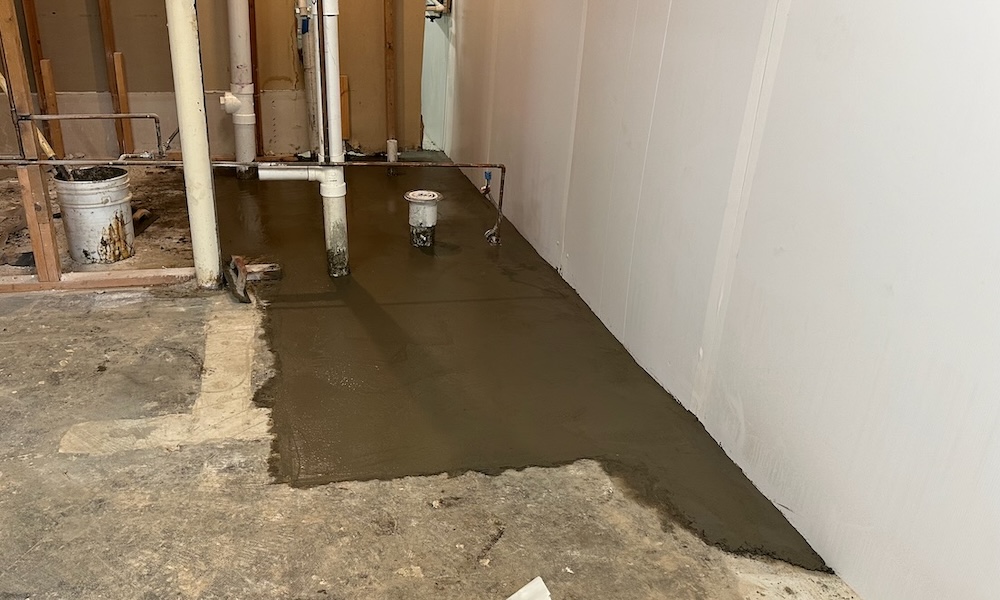
Then, the concrete contractor came and covered up the big hole where the plumbers replaced cast iron drain pipes (photo above). They also dug a hole for a footing to hold a new column and then filled the hole with new concrete.
So, there’s a lot less leakage area for soil gases to get into the house.
Radon level timeline
Now, how has the radon responded during all that’s happened? You’ll see the graphs in the next section, but let me provide a general timeline here of my radon measurements and basement status.
Early April 2023. Did a 7-day radon test and radon level was 7.7 pCi/L. Tested main floor, not basement.
20 May through 23 Sep. 2023. Alpha track test resulted in 10.3 pCi/L of radon. Tested basement.
13 July 2023. Installed Airthings Space Plus continuous radon monitor with sensor on main floor.
27 May 2023. Opened old perimeter drain in one room of basement.
9 Feb. 2024. Basement renovation started with day of demolition.
27 Feb. 2024. Basement slab closed up after replacement of perimeter drains and new concrete over other work.
That will provide the context for the radon level graphs below.
Early radon reduction results
The first graph here shows our daily average radon level since I put in the Airthings monitor on 13 July. Before the renovation started, we were averaging pretty much the same radon level I got in my seven-day test last April: 7.7 pCi/L. With the recent reduction in radon level, that average is now down to 7.4 pCi/L, as you see below.

Looking at the radon data over a shorter time period, the past month, we can see that the radon level dropped about ten days into the basement renovation (~19 Feb.). After the slab holes were filled last week, it dropped even more.

The 48-hour graph below shows several periods of the radon level staying at 0.0 or 0.1 pCi/L for hours at a time. Wow!

So, we have some significant radon reduction going on here. But…
Is it too soon to declare victory?
Yes, absolutely! It’s definitely too soon to declare victory. First of all, the house isn’t in its normal state because of the basement exhaust ventilation and the plastic sheeting separating the work zone. Also, things change seasonally and with weather patterns. Notice in the first graph that we had a couple periods of low radon levels last September and October.
But, I definitely have reason to be hopeful that there’s some significance in the radon reduction I’ve seen already. The lows we had last fall bottomed out at 2.0 pCi/L, whereas the recent lows have been 0.0 pCi/L. Also, I still have some sealing to do. I had to remove some of the wall plastic and haven’t resealed those edges yet. And there’s the closet hole and a few other little places still to seal, too.
I didn’t expect to see such a dramatic and quick reduction in my radon levels at this stage, but it makes me happy to see where we’re at now. And it provides (with the caveat of needing more data) some justification for all the money we’ve already spent on this project.
Radon update, May 2024
After I published this article in March, I made an accidental discovery. In the second section above, “Soil gas leak sealing, so far,” I mentioned the exhaust fan I’ve had running in my basement since I began this project in February. Well, I turned it off one day and then forgot to turn it back on until the next day.

The graph above shows what happened. The radon level spiked up to 12 pCi/L. When I turned the fan back, the radon level dropped back to the safe level. So it seems that the slab sealing I’ve done so far may not be the reason for low radon levels for the past few months.
Stay tuned. I’ll let you know what happens when the basement is all done and the temporary fan removed.
____________________________________________________________________
Allison A. Bailes III, PhD is a speaker, writer, building science consultant, and the founder of Energy Vanguard in Decatur, Georgia. He has a doctorate in physics and is the author of a bestselling book on building science. He also writes the Energy Vanguard Blog. For more updates, you can subscribe to Energy Vanguard’s weekly newsletter and follow him on LinkedIn. Images courtesy of author.
Weekly Newsletter
Get building science and energy efficiency advice, plus special offers, in your inbox.















11 Comments
I had a similar situation in my 1941 home in CT. Basement is a 2" rat slab on dirt. Pretty poorly built.
Discovered radon levels up to 22 PiC/L after I bought an AirThings View Plus... now I know why I have asthma! We decided to install a cheap ERV in the basement with the exhaust air going straight out of the rim joist and the fresh air getting dumped into the space from a duct maybe 20' deep into the basement. We're steadily below 1.0 PiC/L at all times now in the basement and throughout the house! Seems like the optimal cheap fix.
jhwehrli,
"...now I know why I have asthma!"
I think it's a bit early to draw that conclusion. The EPA says:
"There are no immediate symptoms from exposures to radon... There is no evidence that other respiratory diseases, such as asthma, are caused by radon exposure"
I agree here. Radon is thought to increse the long term risk of lung cancer, primarily, and it's a statistical thing, i.e. more exposure increases your chances. There is also some reasearch out there that says the risk posed by radon is often overstated. I've never seen radon linked to anything other than cancer risk though.
Asthema and allergies are much more likely to be triggered by mold and dust, which are different issues. I think some of the sealing/encapsulating that can help with radon will also help with mold though.
Bill
I have never heard from a legitimate source that radon "is thought to increase risk" or the it's strictly "a statistical thing" (any more than any risk is based on statistics.)
The EPA states definitively that radon is the leading cause of lung cancer among non-smokers. The method of how it causes cancer is well understood--it's strong, rapid radioactive decay within the deepest parts of your lungs, which leads to DNA damage. https://www.epa.gov/radon/health-risk-radon
While some say that radon risk is overstated, the EPA limit of 4 pc/l is "35 times as much radiation as the Nuclear Regulatory Commission would allow if that family was standing next to the fence of a radioactive waste site." (https://www.radon.com/radon_facts/). The data is extrapolated from miners with very high levels of exposure so nobody really knows the exact limit that is safe. Indoor levels also change significantly over time; when it rains, for example, indoor levels usually spike.
While I agree that mold and dust are more likely than radon to cause physical symptoms, some experts say that radon exposure can lead to physical symptoms as well: https://www.cancer.org/cancer/latest-news/radon-gas-and-lung-cancer.html#:~:text=Possible%20symptoms%20include%20shortness%20of,very%20important%20to%20quit%20smoking..
Michael,
I hope my comment didn't seem like I'm diminishing the importance of radon mitigation. I just think it's important to stay as close as we can to what the science presently says the risks include.
I also didn't meant to say radon isn't a risk, it's probably just my wording (especially the "statistical thing") part. What I meant was that radon is linked specifically to lung cancer, but being exposed doesn't GUARANTEE you'll get lung cancer, it just makes it MORE LIKELY that you will. I would definetely work to mitigate high radon levels if found (and I did exactly that in my own home). I never meant to dismiss things as a sort of "naw, it's not something to worry about" kind of way.
A lot of the exposure limits are very, very conservative. This isn't a bad thing thing though, since some people are more susceptible than others. My wife is at increased risk of some cancers due to genetics, for example, so I was extra careful about getting the radon levels down when I discoved them. I put a lot of effort into finding a place to run a diagnostic test for her with an MRA instead of a CTA earlier in the year for similar reasons: ionizing radiation damages DNA, so limiting exposure as much as you can is likely to reduce your long term risks. It doesn't hurt to be careful.
Chasing zeros, as I like to say, isn't likely to help you much here though. I see levels of 0.0 to about 0.9, which vary with various things ("various things" means I've been trying to link the variations to something like humidity levels, wind, temperature, etc., but haven't found anything that seems to track yet). That's about as good as I can get, so I don't freak out about it. It's a whole lot better than the 9-16 or so I used to see.
BTW, there have been some studies (and I don't have links handy, unfortunately), showing that people who live in areas with high levels of naturally occuring background radiation actually have a lower overall incidence of cancer in their populations. There is still more to learn about this stuff. For now though, I do agree it's a good idea to put in radon mitigation systems -- which usually aren't even very expensive -- if you have levels exceeding the recommended upper limits.
Bill
Because most people underestimate the risk of radon exposure, if they understand it's a risk at all, and because it's colorless and odorless so you can't physically detect it, I think it's worth being abundantly clear when discussing it that it's a serious health issue. Not just a risk as in, if you're unlucky you might get hit by a car, but risky in that the more time you spend in a high-radon environment, the more likely it is that you are going to get lung cancer.
A simple passive radon mitigation "system", which is really just a vertical run of PVC pipe to the outdoors, might be enough here. Tied into the corrugated perimeter drain, stack effect in the pipe might be enough on its own to take care of the radon issue. You can always add a fan to the pipe to turn the passive system into an active one if the passive system alone turns out not to be enough. Subslab depressurization is the usual way to deal with excessive radon levels.
Bill
How long should I continue monitoring the radon levels after sealing? It makes me remind to https://www.greenbuildingadvisor.com/article/air-sealing-a-net-zero-assembly slope game
It depends how concerned you are. Most people test for 24-48 hours, and that's what ASTM E-1465, which governs radon testing, calls for. In my opinion, if you have a reasonably high risk of radon, that's not enough. A couple of weeks, including at least one soaking rainstorm (if it rains often in your area) would be better. Ideally you'd invest in a long-term radon monitor. It's on my list to get one soon.
The mail-back test kits usually want you to mail them after a week. If you're trying to see what your levels are after doing some mitigation work, I'd watch things for at least 3 months. The reason for this is that there are often seasonal changes, and you want to make sure you aren't just seeing seasonal variations and thinking you're good.
I second Michael's suggestion to get an electronic monitor if you know you have radon issues. I use the same Airthings monitor mentioned in the article, and I've been using it for nearly a year now. It seems to do a good job, and the sensors also read humidity, which is good to know in crawlspaces and basements. I have a radon sensor in the crawlspace, and another near my sump pump pit in the basement (which is now sealed and covered since I put in the radon system). I have a VoC monitor on the main level too, and will add a CO monitor at some point. If you get their hub, you can read all those sensors from anywhere using their app, otherwise you have to read them through bluetooth when you're reasonably close to them. It's good to see historical data on the levels so that you can be sure you are ALWAYS in the safe zone.
Bill
Log in or create an account to post a comment.
Sign up Log in